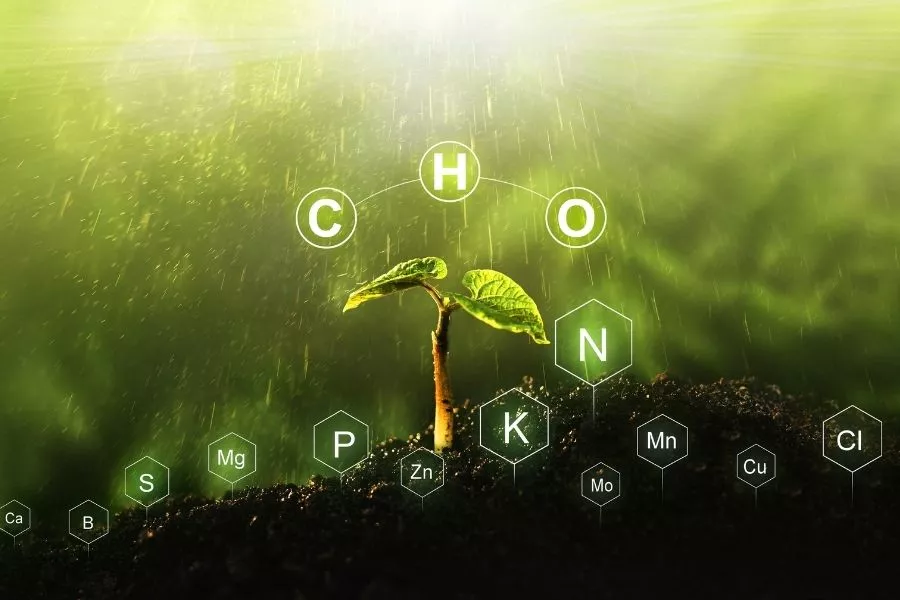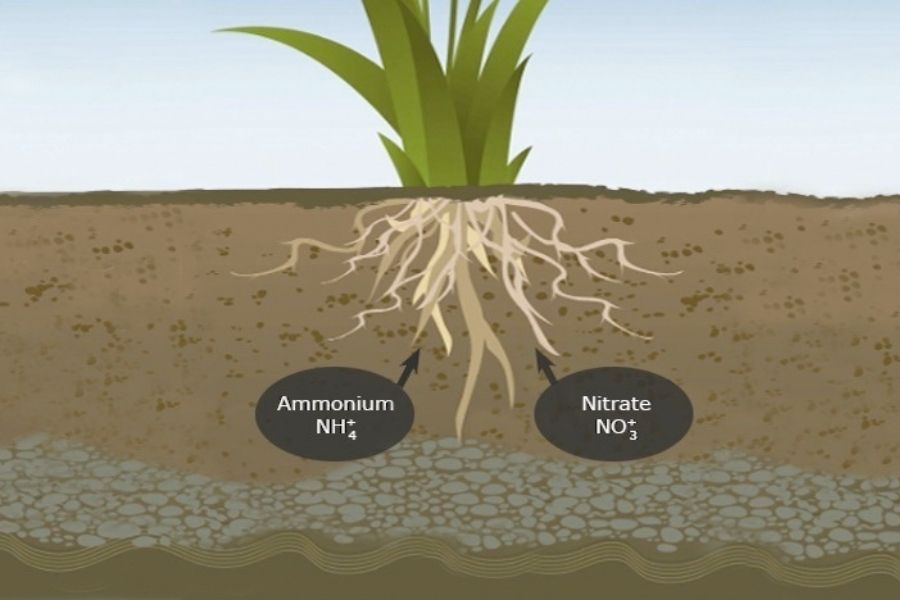By reading this article, you’ll learn how to add nitrogen to soil with the help of this guide to improve plant growth and yield, reduce pests and diseases, and improve soil quality.
Nitrogen in soil is one of three macronutrients vital to encourage proper plant growth. So, let’s look at why adequate nitrogen is essential for plants and how to add nitrogen to nitrogen-deficient soil.
A soil test can tell you how much nitrogen is already in your soil and how much your plants need. If your soil needs more nitrogen, there are several ways to add it. One way is to use a commercial fertilizer that contains nitrogen. Another way is to add organic matter to the soil. This can be done by adding compost or by planting cover crops.
Nitrogen is essential for plants to grow and produce food. Nitrogen is also necessary for the health of soil organisms, which play an important role in the cycling of nutrients and organic matter. When nitrogen is applied to soil in the form of fertilizer, it can improve plant growth and yield, reduce pests and diseases, and improve soil quality.
Sources of Nitrogen

Nitrogen is an important nutrient for plants and is found in the soil in two forms: organic and inorganic. Organic nitrogen is bound to carbon molecules and is released slowly into the soil. Inorganic nitrogen is a gas and is available immediately to plants. The most common sources of inorganic nitrogen are urea, ammonium nitrate, and ammonia.
Urea is made up of 46% nitrogen and 54% carbon. It is a solid that dissolves in water and can be applied as a liquid or dust. Ammonium nitrate is made up of 33% nitrogen and 67% oxygen. It is a solid that dissolves in water and can be applied as a liquid or dust. Ammonia is made up of 78% nitrogen and 21% hydrogen.
There are two alternative routes to fix the soil’s nitrogen deficiency.
- Organic sources.
- In-organic sources.
These two routes split into many effective ways to add nitrogen to your ground.
Organic Sources of Nitrogen:
Organic nitrogen sources are a great way to improve your soil fertility. These include things like coffee grounds, animal manure, and green manure crops. Using organic nitrogen sources helps improve the structure and tilth of your soil, while also adding important nutrients like nitrogen and potassium.
One of the best things about using organic nitrogen sources is that they help keep your soil healthy and alive. This is because organic materials break down slowly over time, releasing their nutrients gradually into the soil. In contrast, chemical fertilizers can leach away quickly, potentially damaging your soil’s health in the process.
Using organic nitrogen sources is also a great way to reduce your reliance on chemical fertilizers. Not only are they better for your soil, but they’re also better for the environment. Organic nitrogen sources include organic matter, compost, and manure.
Organic matter:
It is one of the most common forms of nitrogen in the soil.; a complex combination of carbon, hydrogen, and oxygen. Organic matter can be replaced with chemical nitrogen sources such as urea or ammonium nitrate. However, this method is both expensive and difficult to implement.
Compost:
Composting is the best method to utilize when adding organic nitrogen sources to your soil. Composting involves decomposing organic matter into a stable form of fertilizer for plants through anaerobic microbial activity. The best way to use compost as a nitrogen source is by making it into a liquid by adding water (if necessary). This allows plants to take advantage of the nutrients in compost at their root zone level.
In addition to composting, you can also make your homemade fertilizer from waste materials in your trash bin or yard waste bin like leaves or grass clippings.
Composting at home: a step-by-step guide:
To make this homemade fertilizer for the soil in use, you will need:
- 2 cups dry brown leaves (or grass clippings)
- 1 cup sawdust (wood shaving)
- 1 cup shredded newsprint
- 1 cup shredded paper towels
- 2 cups peat moss (or other soil conditioners)
- 1 cup well-rotted manure or wood chips
Once all your ingredients are ready, mix them in a large bowl and cover them with water. Let’s sit for 24 hours. Following the 24-hour wait period, strain the mixture through a cheesecloth or a piece of fine mesh. You will be left with a rich fertilizer for your lawn, which you may use just like any other fertilizer.
Manure:
Organic farmers rely heavily on manure as a source of nitrogen. Producers face difficulty determining the actual amount of nitrogen available for plant usage. A nutrient management strategy is required for evaluating nitrogen requirements for crops. The nitrogen concentration and availability of manure vary substantially depending on the animal species that produced it. Such as, The highest nitrogen level is found in poultry manure. The amount and kind of bedding added to manure will impact the concentration and availability.
Inorganic Sources of Nitrogen:

There are many non-organic forms of nitrogen for soil that can be used to enhance plant growth. In addition to these various forms of nitrogen, there is also an abundance of other organic materials to be used as a fertilizer for your soil. Of course, many other organic materials could be used as a nitrogen source for your soil. However, these are the most common and often the easiest to find.
How to add nitrogen to soil:

Test the soil first:
Heavy N applications above 10% can lead to over-stimulation of plant growth at the root zone and cause damage to plant tissue. This is because plants cannot use enough nitrogen in one application to meet their needs for growth. If this occurs, a soil test should be performed to determine if an application of N-P-K fertilizer is necessary.
Determine the nutritional content with accuracy:
N-P-K is a more accurate method of determining how much nitrogen and other nutrients your plants need so that you can feed them correctly. The amount of N-P-K fertilizer you apply should be based on soil test results from your local extension office or university testing lab using an Agronomy Lab Test Kit (ALT). These kits give you a precise technique to determine how much of each nutrient your plant needs to develop healthily and efficiently without overfeeding or underfeeding it.
Use a well-balanced fertilizer:
Fertilizers that are not balanced with other nutrients can cause your plants to become unhealthy and may even kill them. This is because the excess nutrients that are not utilized by the plant may lead to a build-up of toxins in the plant tissues. The build-up of these toxins can often be seen as yellowing leaves, stunted growth, or even death. This is why it is so important to ensure that you use a balanced fertilizer with other nutrients to maximize its effectiveness.
Contact with an expert:
Suppose you are unsure of which fertilizer will work best for your soil. In that case, you can contact your local extension office or university testing lab for advice on getting the right balance of nutrients in your soil.
Apply the fertilizer at the correct time:
The rule of thumb for when to apply fertilizer is one application per month, depending on how much nitrogen and other nutrients are needed by the plants. For example, suppose you have very sandy soil and need a lot of nitrogen. In that case, you should apply fertilizer every 3 weeks instead of once per month.
Various forms of organic materials:
There are many different organic materials, such as peat moss, composted manure, etc., that can be used as an organic form of nitrogen for your soil. The following list contains some of the most common organic materials that can be used to provide nitrogen to your soil.
- Composted manure
- Composted yard waste
- Shredded paper towels or rags (in moderation)
- Pine needles or needles from other types of evergreens (in moderation)
- Organic peat moss (in moderation)
- Organic vermiculite or perlite (in moderation)
Suppose you have questions about which organic materials can be used to provide nitrogen to your soil. In that case, you can contact your local extension office or university testing lab for advice on how much material you should use at one time.
Nitrogen is an element that is essential to plant growth. A lack of nitrogen in the soil will limit the plant’s size and production. Adding nitrogen to the soil can help to overcome this limitation. There are several ways to add nitrogen to the soil, including using organic or synthetic fertilizers, planting legumes, or adding manure.
A lack of nitrogen can result in stunted plants with a reduced yield. Soil nitrogen levels can be increased by adding nitrogen-rich fertilizers to the soil. The most common form of nitrogen fertilizer is ammonium nitrate. Ammonium nitrate is a powder that can be broadcast over the soil or mixed into the soil before planting.
Nitrogen is a nutrient that is essential for plants to produce proteins and DNA. There are several ways to add nitrogen to the soil, including using organic or inorganic fertilizers, crop rotation, and legumes. Inorganic fertilizers are the most common way to add nitrogen to the soil. They come in either solid or liquid form and contain either ammonium nitrate or urea. Crop rotation is another way to add nitrogen to the soil.
Final Thoughts:
In general, organic materials are a good nitrogen source for your soil. However, if you apply too much of these materials at once, your plants may not be able to use all of the nutrients. In this case, it is best to apply the material in small quantities so that the plants can get all of the nutrients that they need.



